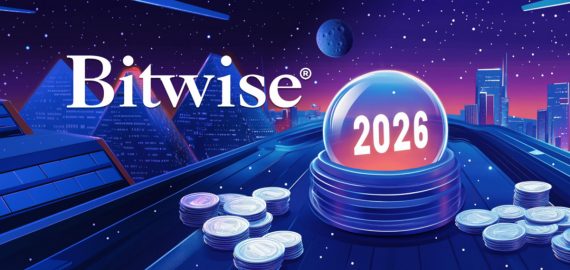RGB Bolsters Bitcoin and Lightning Network’s Scalability and Privacy Capabilities

In Brief
RGB is a layer 2/3 solution on Bitcoin and Lightning Network that bolsters scalability and privacy capabilities for securing Smart Contracts.
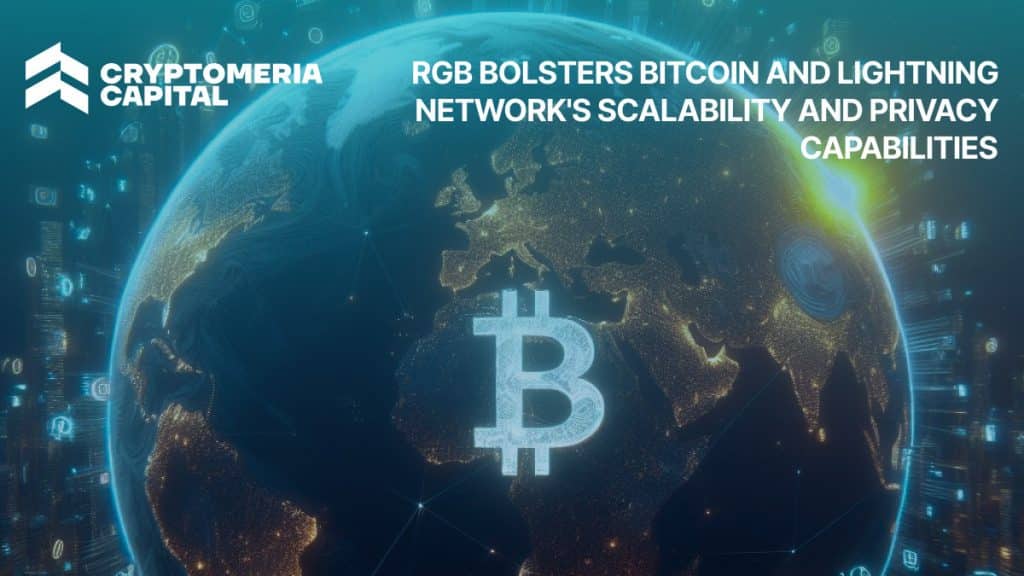
TL;DR
- RGB operates as a Layer 2/3 solution on the Bitcoin and Lightning Network.client-side validation paradigm, housing all smart contract data outside Bitcoin transactions. This design ensures the system’s operation atop the Lightning Network, eliminating the need for modifications to LN protocols.
- RGB smart contracts are designed for scalability and confidentiality. The system supports private and mutual ownership, abstracts and separates concerns, representing a post-blockchain, Turing-complete form of trustless distributed computing without the necessity of introducing new tokens.
- RGB contracts are organized in separate segments called “shards,” each with its own history and data, enhancing scalability and preventing the mixing of histories from different contracts. They interact via the Bifrost protocol on the Lightning Network, enabling coordinated changes among multiple parties, similar to DEXes operating on the Lightning Network.
- RGB employs single-use seals defined over Bitcoin UTXOs for security. Any party possessing smart contract state history can verify its uniqueness, leveraging Bitcoin’s script to define ownership and access rights.
- In RGB, state ownership and validation are separate entities. Ownership is managed by the Bitcoin script, a non-Turing Complete system. Validation rules, on the other hand, are dictated by the RGB Schema using the Turing Complete Simplicity/Contractum/Rust Script.
- Each RGB smart contract is associated with a unique state using single-use seals. The seals and state follow specific rules and validations set by the contract’s creator, governed by a “schema”. This schema acts like a rule set for checking contract data on the client side, enabling a high level of protocol scalability and privacy.
- RGB’s design is highly interoperable with existing Bitcoin and Lightning Network technologies, facilitating seamless integration with these platforms and any future upgrades.
- Unlike the imperative programming style of many blockchain platforms, RGB employs a declarative style. This approach focuses on outlining the desired outcome rather than detailing the specific steps to achieve it.
- RGB utilizes various advanced technologies, including AluVM for deterministic portable computing tasks, PRISM for partially-replicated infinite state machines computing, and Storm for escrow-based trustless storage using zk-proofs. These technologies contribute to RGB’s robustness, confidentiality and extensibility.
- RGB (v0.10) introduces notable enhancements to user experience and integration processes, streamlining operations and minimizing dependencies. The updated version features a more unified library API and command-line tool, making it more accessible and user-friendly.
Short description
RGB is a protocol designed for issuing tokens on the Bitcoin network with enhanced privacy and compatibility with the Lightning Network. It builds on the concept of “colored coins,” like those used in the OmniLayer protocol where metadata in Bitcoin transactions indicates a token transfer. For example, USDT transactions on OmniLayer function as Bitcoin transactions augmented with additional data detailing the USDT token movements. However, these methods face limitations such as data size constraints in OP_RETURN outputs, intensive blockchain scanning and restricted privacy stemming from on-chain visibility.
RGB addresses these issues by relocating majority of the validation processes away from the Bitcoin blockchain. It adopts client-side validation and employs single-use seals to connect tokens with Bitcoin’s UTXOs, all the while preserving user privacy.
Tokens are transferred by committing to a message containing RGB payment information within a Bitcoin transaction, allowing the tokens to move from one UTXO to another without leaving a trace on the Bitcoin transaction graph. This significantly enhances privacy, as RGB transactions “teleport” tokens discreetly, with RGB-specific data passed through private off-chain channels.
Additionally, to ensure ownership and prevent inflation, receivers must validate the entire transaction history of the tokens received. RGB enables future upgrades without the necessity for hard forks, ensuring miners are unable to trace asset flow, thereby providing a higher resistance to censorship. Unlike traditional blockchain structures, RGB operates without the need for blocks or chains, positioning it as a non-block decentralized protocol, promising high confidentiality, security and scalability.
Introduction and Vision
One-liner: A client-validated state and smart-contract system operating at Layer 2/3 in Bitcoin and Lightning Network.
More details:
RGB is a scalable & confidential smart contracts system for Bitcoin & Lightning Network. RGB smart contracts operate with client-side validation paradigm, housing all smart contract data outside Bitcoin transactions, i.e. Bitcoin blockchain or Lightning channel state. This allows the system to operate on top of Lightning Network without any changes to the LN protocols and also gives a foundation for a high level of protocol scalability and privacy.
Smart contracts embody principles of private and mutual ownership, abstraction, and the separation of concerns. They represent a “post-blockchain,” Turing-complete form of trustless distributed computing that does not require introduction of tokens.
RGB contracts operate in separate segments called “shards.” Each shard has its own history and data, meaning different contracts don’t mix their histories. This method improves scalability. The term “shard” is used to show that RGB achieves similar goals to what was intended with Ethereum’s shards concept.
Although they function independently, RGB contracts can interact through the Bifrost protocol on the Lightning Network. This allows for coordinated changes between multiple parties. For example, it enables DEXes to function over the Lightning Network.
Technology & Architecture
High-level Overview of RGB Operation and Single-Use Seals
Figure 1. High-level overview of operation of RGB.
Source: LNP/BP Association Github.
As a security mechanism, RGB utilizes single-use seals defined over bitcoin UTXOs, which provide the ability for any party having smart contract state history to verify its uniqueness. In essence, RGB leverages Bitcoin script for its security model and defines ownership and access rights.
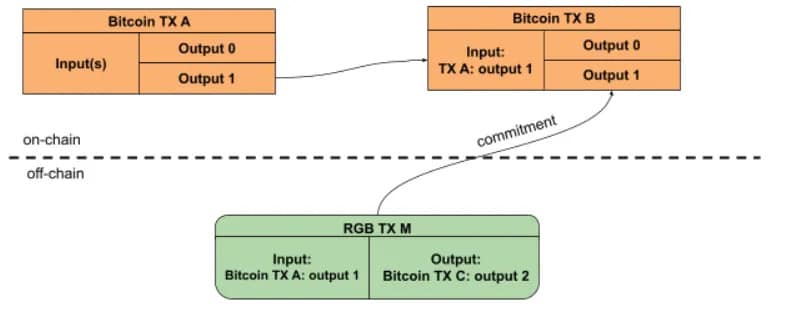
Figure 2. RGB High-level working principle.
Source: “Driving Mass Adoption of Crypto: How the RGB Protocol is Illuminating the Future of Bitcoin” by Waterdrip Capital.
Each RGB smart contract is defined by a genesis state, crafted by the smart contract issuer (or, put simply, issuer)and a directed acyclic graph (DAG) of state transitions maintained as client-validated data.
Figure 3. Transactions, closed seal and witness.
Source: LNP/BP Association Github.
We can summarize it as follows: each transaction has a UTXO, and ownership of this UTXO grants the owner the right to possess the state. Ownership determines who can modify the blockchain state and “spend” the UTXO. The individual holding the state is referred to as the party owning state.
The party holds the authority to modify the relevant section of the smart contract state by generating a new state transition and confirming it in a transaction, utilizing the output containing the previous state.
The process signifies closure of a seal over the state transition, and a pair comprising the spending transaction and corresponding extra-transaction data on the state transition is termed a witness (depicted in an image above).
Ownership & Access: Core Properties

Figure 4. Ownership and Access.
Source: LNP/BP Association Github.
State ownership and validation are distinct concepts. Validation rules specify how the state may change, while they do not identify who may effectuate the change.
On the other hand, ownership is controlled by Bitcoin script at the Bitcoin blockchain level, which is not Turing Complete. In contrast, validation rules are governed by the RGB Schema utilizing Simplicity/Contractum Script i.e. being Turing Complete.
RGB Schema
In RGB smart contracts, each contract is assigned a unique state through single-use seals. These seals, along with the state, have specific rules and validations, set by the contract’s creator at the beginning. This setup is governed by a “schema,” functioning as a set of rules to validate contract data on the client side. The schema can include complex scripts integral to the contract’s logic.

Figure 5. RGB Schema.
Source: LNP/BP Association Github.
Client-side Validation and Design Principles
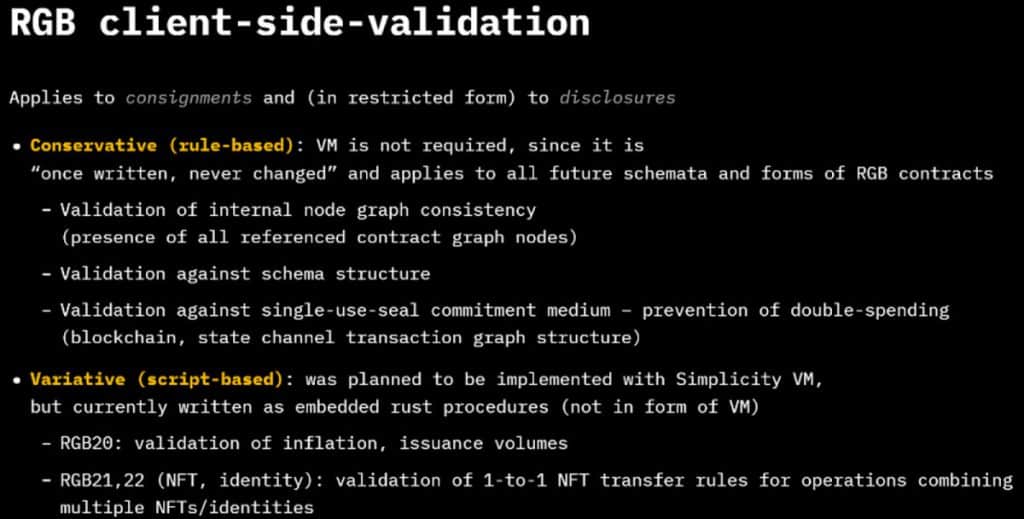
Figure 6. RGB Client-side-validation.
Source: LNP/BP Association Github.
- Strong Ownership: In RGB, smart contracts have a clearly defined owner or owners. Only designated owners hold the authority to modify the contract’s state. These contracts outline distinct rights or operations categorized as either public (accessible to all) or owned (restricted to the owner).
- Confidentiality: Information within the contract is kept confidential, known only to the participants, especially the owners of the state. Participants have the option to make certain data public, but by default, all information is private. This confidentiality prevents external analysis tools from accessing the data, ensuring that no sensitive information is stored on public ledgers.
- Separation of Concerns: RGB features a modular design with distinct layers, each assigned a specific task. These layers operate independently, eliminating the necessity for lower layers to be aware of the higher layers’ structure. This design enhances the organization and efficiency of the system.
- Extensibility: The system is easily extendable, allowing for the creation and integration of advanced smart contracts without the necessity to modify the core protocol or recompile the entire RGB library.
- Determinism: RGB’s validation logic is deterministic, consistently yielding identical results with the same inputs and the prevailing state of underlying blockchain or Lightning Network channel. This consistency is achieved through two main components: a. The core validation logic, written in Rust, is the same across all systems running RGB. b. Contract-specific validation logic runs on AluVM, a virtual machine that provides a consistent set of instructions regardless of the platform.
- LNP/BP Interoperability: RGB is designed to work seamlessly with existing Bitcoin and Lightning Network technologies. It’s also built to be compatible with any future upgrades to these technologies.
Approach of RGB and Pure Blockchain/L1 approach
Pure blockchain/L1 approach is wrong, RGB team states.
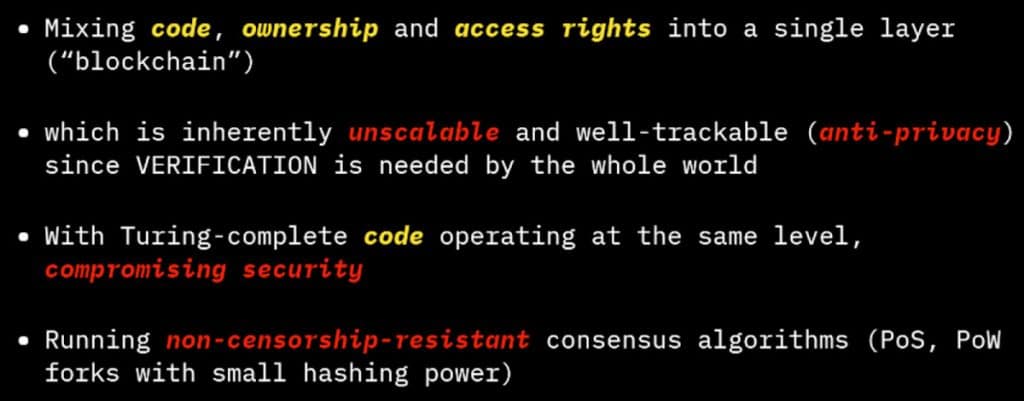
Figure 7. RGB comments on Blockchain/L1 approach.
Source: LNP/BP Association Github.
RGB’s Approach: Declarative vs. Imperative Programming:
- Most blockchain platforms, including Ethereum, utilize smart contracts written in an imperative style. In this approach, the contract functions as a program that explicitly directs the step-by-step execution of tasks, resembling a precise and detailed recipe.
- These imperative programs are often quite restrictive and limited by the capabilities of the underlying blockchain platform. Even though they are sometimes referred to as Turing-complete, they come with significant limitations.
Declarative Nature of RGB Smart Contracts:
- RGB, on the other hand, does not use imperative programming. Instead, it employs a special form of functional programming where smart contracts are defined declaratively.
- In declarative programming, instead of detailing how to do something, you describe what the outcome should be. It’s like outlining what a meal should look like rather than providing step-by-step cooking instructions.
- The “Schema” in RGB is a declarative definition of a smart contract. It specifies the rules and conditions of the contract, but not the exact sequence of operations to achieve them.
Paradigm Shift in Programming:
- Moving from Ethereum’s imperative style to RGB’s declarative style in smart contract programming is similar to the shift from traditional imperative programming to functional or declarative programming in general software development.
- This shift requires a different mindset: focusing on the “what” (the desired results) rather than the “how” (the specific steps to achieve those results).
Simplicity
The original plan involved incorporating Simplicity into RGB, and efforts were dedicated to ensuring compatibility from day 1. However, given the sluggish progress of Simplicity development and the uncertainty surrounding its release timeline, it became evident that relying on it was impractical. The ongoing RGB release, currently in preparation, raised questions about Simplicity’s inclusion.
Recognizing the absence of a reliable timetable for Simplicity, we initiated an examination of alternatives (WASM, EVM (as a joke), IELE etc). Eventually, it became apparent that developing a proprietary virtual machine for RGB was the only viable option, replacing the initial reliance on Simplicity.
Hence we decided to create AluVM – pure functional, highly-portable Rust-based virtual machine for client-side-validated smart contracts (RGB), Lightning Network, deterministic distributed and edge computing.
Prism
PRISM stands for “partially-replicated infinite state machines” computing.
RGB technology defines rules for evolving smart contracts at a basic level, called Schema, but it doesn’t limit all future actions of the contract with a single, overarching algorithm. Instead, each node on the network performs individual operations, and both the contract’s state and the contract itself remain valid as long as these operations adhere to the Schema’s rules.
Moreover, this approach doesn’t constrain the contract’s historical evolution with a predetermined algorithm. Thus, a contract can exhibit varied behaviors as long as each change meets specific validation rules. This method focuses on local rules rather than a global algorithm.
In contrast, Ethereum uses a global algorithm where every operation affects the entire state of the smart contract. With RGB, you work with only a part of the contract’s state, applying rules locally. This provides a broader range of possibilities for contract evolution.
Below you can see a high-level view on the differences between state channels and client-side-validation:
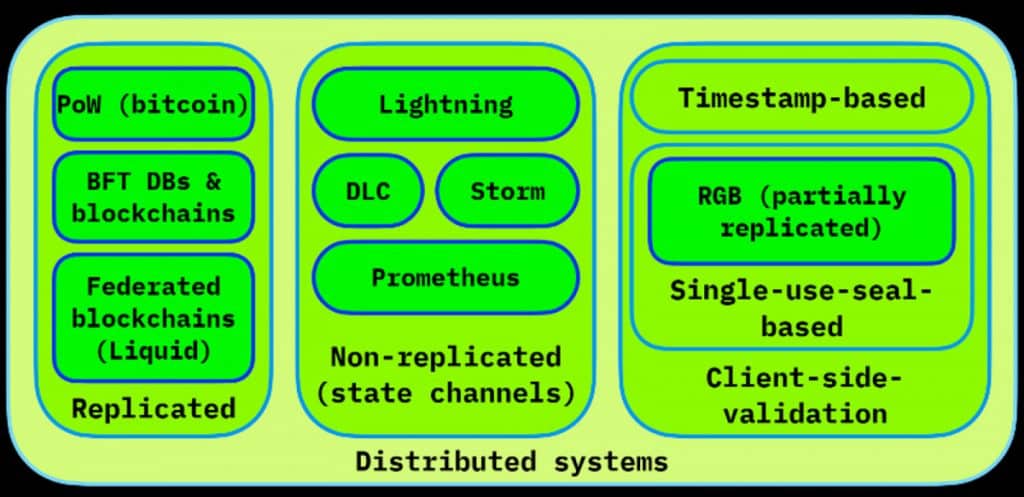
Figure 8. Distributed systems separation.
Source: LNP/BP Association Github.
More specific differences are as follows:
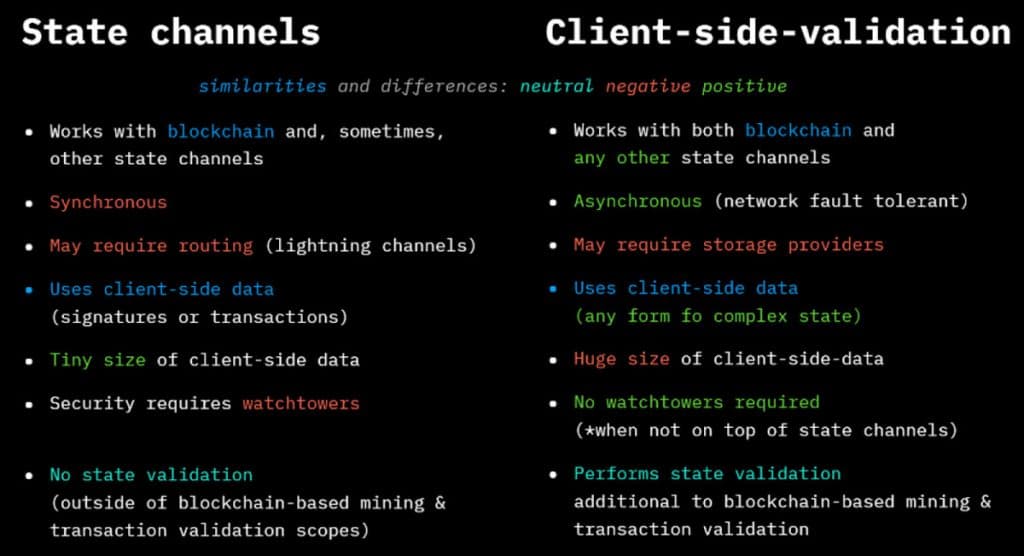
Figure 9. Comparison of State Channels and Client-side-validation.
Source: LNP/BP Association Github.
AluVM
AluVM – (algorithmic logic unit VM) is a pure functional RISC virtual machine designed for deterministic portable computing tasks
AluVM distinguishes itself by employing a register-based system that prohibits random memory access. This design enhances AluVM’s suitability for applications such as smart contracts, remote code execution and distributed and edge computing. The core strengths of AluVM lie in its determinism, robustness and capacity for formal code analysis.
Key characteristics: Exceptionless, Portability, Sandboxing, Security, Extensibility.
The Instruction Set Architecture (ISA) of AluVM is designed to be adaptable, allowing it to create different runtime environments for various applications. AluVM itself is a highly predictable, functional, register-based virtual machine and ISA.
While restricting random memory access, the AluVM ISA excels in performing arithmetic tasks, including those related to elliptic curves. Uniquely, the VM’s environment can expand the AluVM ISA, enabling the addition of functionalities such as loading data into the VM’s registers and supporting specialized instructions (e.g., SIMD) tailored for specific applications.
AluVM is mainly intended for use in distributed systems where consistency and reliability across different platforms are more crucial than processing speed. The primary uses for AluVM, with the right ISA extensions, include blockchain technology, computations critical for consensus in networks, edge computing, multiparty computing (which covers deterministic machine learning), client-side-validation, restricted Internet2 computing, and genetic algorithms. These applications benefit from AluVM’s ability to perform consistently and securely in various environments.
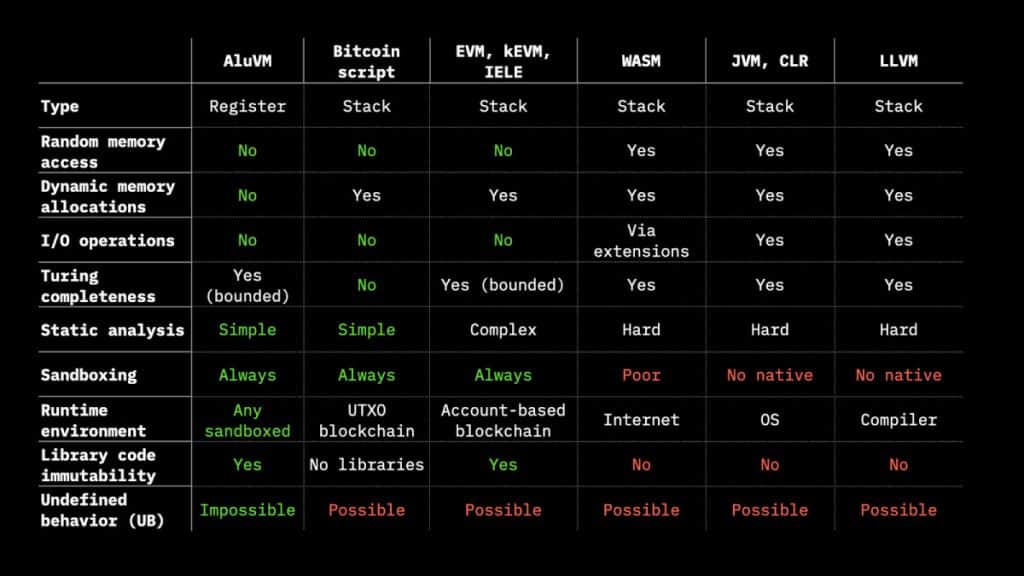
Figure 10. AluVM Comparison.
Source: LNP/BP Association Github.
Contractum
Contractum sets itself apart from other smart contract programming languages by blending the functional capabilities of Haskell with the proximity to the bare metal seen in Rust. It occupies a niche that was previously inaccessible to smart contracts:
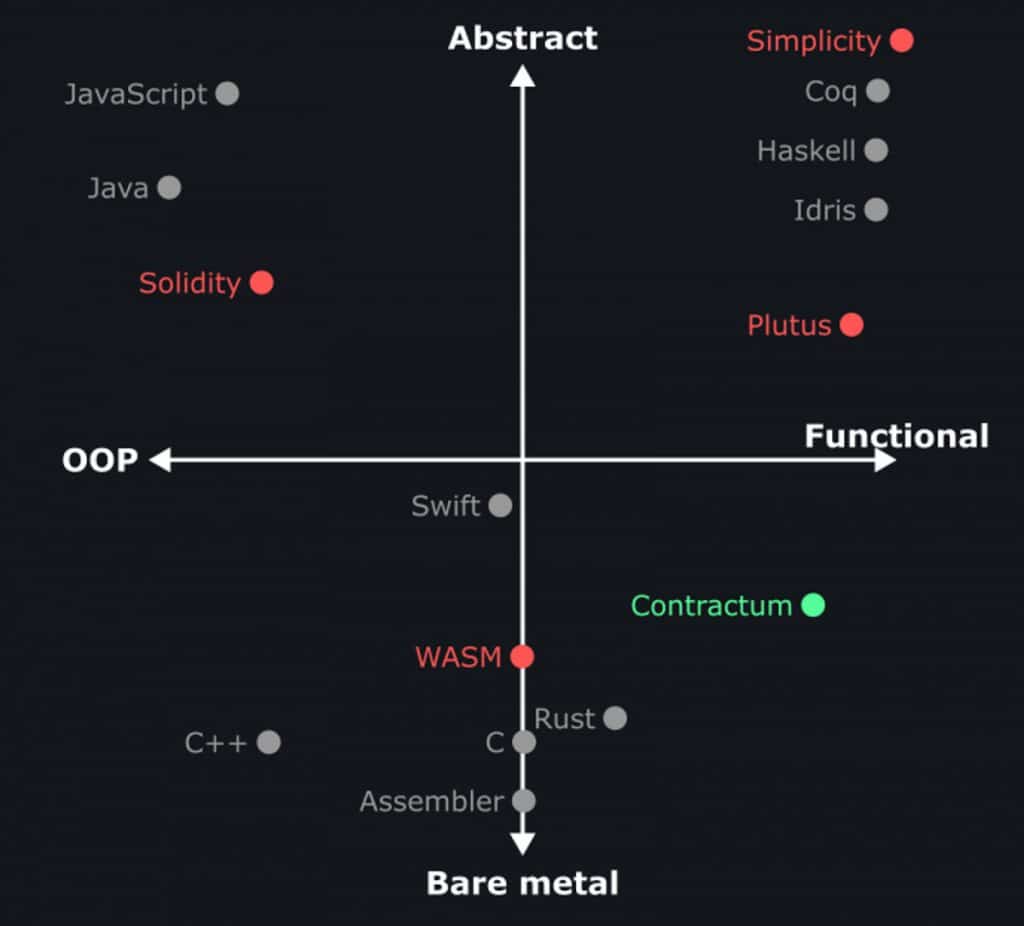
Figure 11. Contractum, Simplicity and other languages comparison.
Source: contractum.org
Contractum is a programming language used to create RGB contracts. Contracts made with Contractum are checked using a method called client-side-validation. This approach doesn’t add any data to the Bitcoin blockchain, which can be compared to a form of sharding technology, further improved with the use of zero-knowledge proofs.
Client-side-validation also separates the contract’s development from blockchain transactions, making it impossible to track or analyze these transactions through traditional blockchain analysis methods.
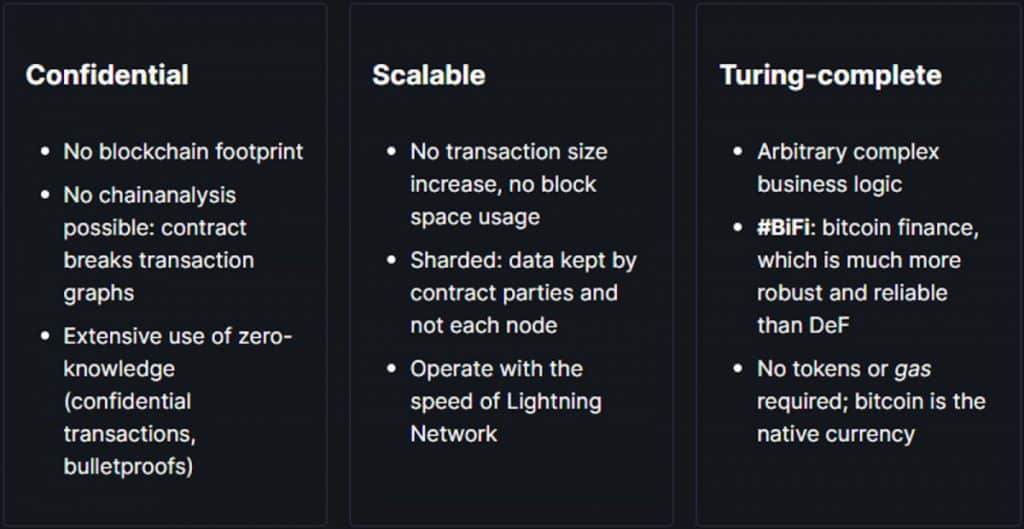
Figure 12. Contractum features.
Source: contractum.org
To engage in Contractum design, it is important to familiarize yourself with the technologies employed by RGB smart contracts:

Figure 13. Technologies that are used by RGB smart contracts.
Source: contractum.org
Recent Updates in New version RGB v0.10
In the latest iteration of RGB (version 0.10), several advanced technical enhancements have been implemented, enhancing the framework’s capabilities for complex application development. These updates primarily focus on the introduction of a Global State for each RGB contract, the integration of contract interfaces, and the adoption of a strict type system.
Global State in RGB Contracts
The Global State feature is a critical innovation in RGB v0.10, enabling each contract to maintain a universally accessible state. This state is accessible not only to the RGB virtual machine but also to external clients such as wallets and other applications.
The utility of this Global State is pivotal for constructing sophisticated applications on the RGB platform, especially those requiring intricate state management like synthetic assets and algorithmic stablecoins. It allows for a more dynamic interaction with the contract’s state, extending beyond the limitations of traditional smart contract architectures.
Contract Interfaces
RGB v0.10 introduces ‘contract interfaces’ as a standardized communication protocol for diverse smart contracts. These interfaces function similarly to Ethereum’s contract ABIs (Application Binary Interfaces) and ERCs (Ethereum Request for Comments).
A key distinction of RGB’s approach is the non-mandatory standardization of these interfaces and their inherent packaging with contracts, eliminating the need for separate distribution. This facilitates semantic-aware interactions between users and contracts via user interfaces in wallets and other software.
These interfaces are not static; developers can augment existing contracts with additional interfaces over time, enhancing functionality without modifying the immutable contract core.
Strict Type System
The new encoding format in RGB v0.10 utilizes a ‘strict types’ system. This system is a novel functional data type approach designed for efficient representation and introspection of contract states within the RGB framework.
The strict type system ensures compile-time assurance of data sizes, which is particularly beneficial for operation on resource-constrained devices, such as low-end hardware wallets with limited memory capabilities.
Furthermore, the entire RGB consensus layer in version 0.10 is compiled into strict types, providing a foundation for formal proofs of binary compatibility across different software releases. This feature not only simplifies and secures the use of RGB but also enables asset issuers and contract developers to append additional metadata to their assets or contracts. Such metadata can play a crucial role in verifying the identity and authenticity of assets or contracts in the RGB ecosystem.
Rust-based Smart Contracts
RGB smart contracts can now be authored in Rust, leveraging the language’s capabilities for type safety and performance.
The strict system type integration facilitates the direct compilation of Rust data types into RGB contract structures, improving the efficiency and reliability of contract code.
Enhanced State Introspection Capabilities
Smart contracts in RGB v0.10 can introspect their own state within the validation code executed by the RGB virtual machine.
This feature is particularly useful for creating complex contracts that interact with Bitcoin transactions, Discrete Log Contracts, and other intricate data structures, enhancing the scope and functionality of RGB smart contracts.
URL-based Invoice Format
The update introduces a new invoice format that replaces the previous Bech32m-encoded system.
These new URL-based invoices are significantly shorter and more user-friendly, facilitating easier verification and automatic opening with pre-configured software.
WASM (WebAssembly) Support
The RGB standard library is now compatible with environments lacking I/O and file system access, such as web pages or browser plugins.
This expands the potential use cases of RGB, allowing it to operate seamlessly in a wide range of web-based applications and extensions.
Taproot Descriptors and Custom Derivation
RGB v0.10 utilizes taproot-based OP_RETURN commitments (referred to as tapret), necessitating descriptor-level support for wallets to recognize transactions with tweaked outputs.
The introduction of custom derivation indexes in this version prevents non-RGB wallets from inadvertently spending outputs containing RGB assets, thereby safeguarding the integrity of these assets.
Simplified Dependencies
The RGB consensus layer in version 0.10 has reduced its dependencies, notably moving away from a custom bulletproof implementation originally derived from Grin projects.
This reduction in dependencies enhances the API’s stability and overall system robustness.
Streamlined Integration Process
The update simplifies operational workflows by reducing the need for multiple API calls and complex cross-language data structure encoding.
RGB contract states are now represented as JSON objects, enabling straightforward serialization across different programming languages.
User Experience Improvements
The new version of RGB simplifies the user experience by consolidating previously disparate components into a unified library API and command-line tool.
While the RGB Node can still be operated on home servers, its use is no longer mandatory for interacting with the RGB system, reducing the barrier to entry for users and wallet applications.
This section includes a special acknowledgment to Waterdrip Capital for spotlighting the latest features in their piece titled “Driving Mass Adoption of Crypto: How the RGB Protocol Illuminates the Future of Bitcoin.”
RGB Competitors
Figure 14. FRGB vs Ethereum in simple words.
Source: LNP/BP Association Github
Taproot
Taproot Assets, formerly known as Taro, is a protocol designed for launching tokens on the Bitcoin network. This protocol leverages the UTXO model of Taproot along with associated solutions like Tapscript and taptweak. These tools are used to store information about the supply and balance of an asset within Bitcoin transaction data.
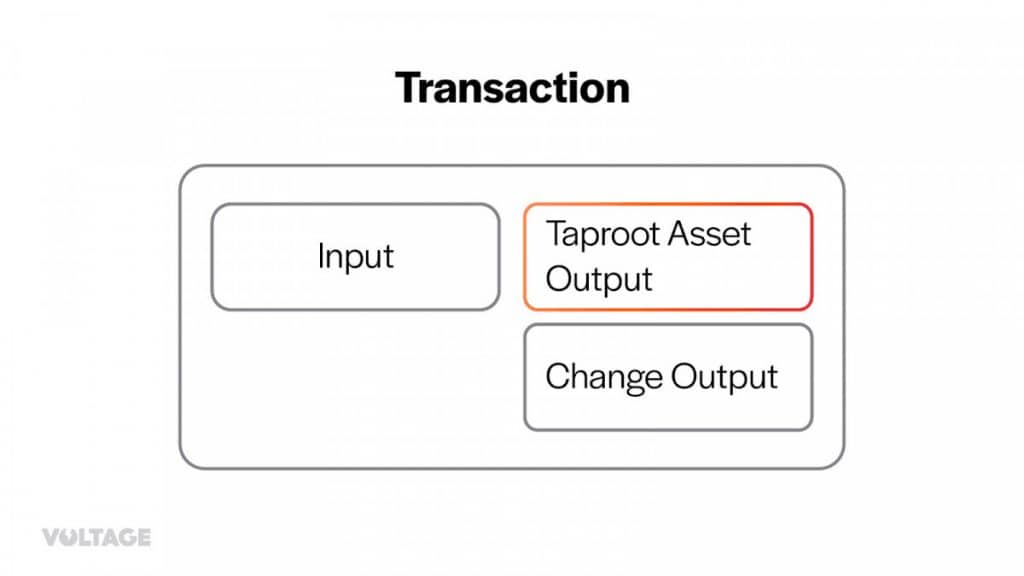
Figure 15. Scheme for storing information about Taproot Assets tokens.
Source: “Taproot Assets: issuing assets on Bitcoin” by Voltage
Taproot Assets employs a method analogous to the Ordinals concept, wherein BRC-20 tokens store supply information in the metadata of enumerated satoshis. Conversely, Taproot Assets embed this information in a Bitcoin transaction’s Taproot output, utilizing what is known as a “sparse Merkle tree.” Essentially, Taproot Assets incorporates a Merkle tree into the Bitcoin transaction, which serves as proof of a specific user’s balance and the overall token supply. This tree, in turn, reflects data from the “Universe” – a repository that maintains the complete asset history and is managed by the token issuer.
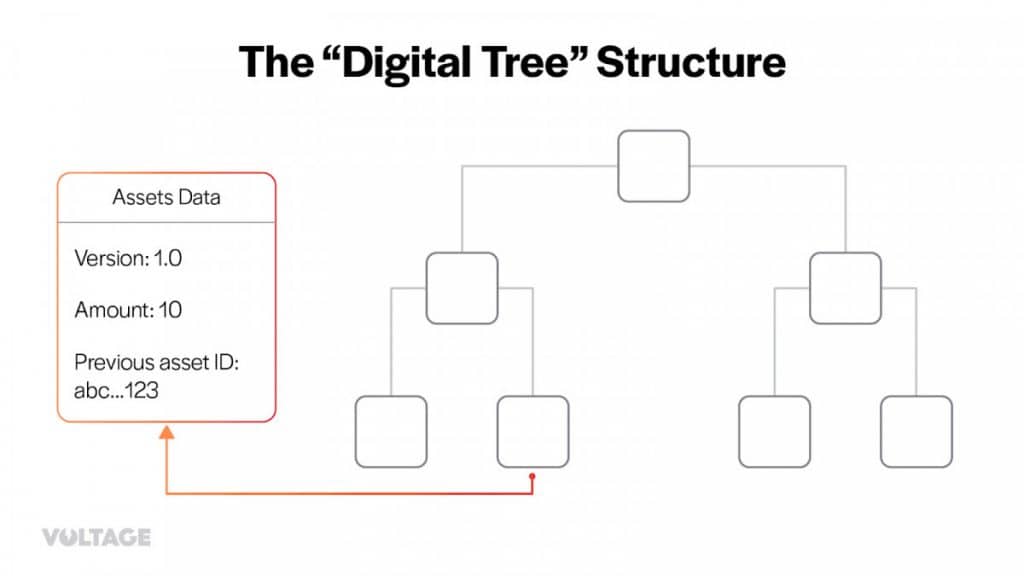
Figure 16. Digital state tree.
Source: “Taproot Assets: issuing assets on Bitcoin” by Voltage
State Digital Tree – The architecture of Taproot Assets offers two options for balance proof: off-chain data from the Universe or the sparse Merkle tree embedded in the UTXO.
Operational Mechanism
- The token creator executes a P2TR (Pay to Taproot) transaction using the Taproot Assets protocol.
- Information about the asset, in the form of a Merkle tree, is stored in the UTXO of this transaction (effectively, the genesis block).
- To transfer the token, the owner of the Taproot key modifies the balance information in the Merkle tree, ensuring the overall asset supply remains constant.
- Such modifications are introduced via a new Taproot transaction. However, for each token transfer, a separate on-chain transaction is not required. Similar to rollups or the Lightning Network, the protocol allows the owner to process a “batch” of transfers, subsequently publishing the updated state of balances.
Advantages of Taproot Assets
- One key advantage of Taproot Assets is its full compatibility with the Lightning Network, enhancing scalability possibilities and reducing transaction costs.
- Taproot Assets creates a distinct layer for recording operations with custom tokens. While it primarily relies on off-chain data, it publicizes the state of balances on the main network.
- This approach is more flexible, scalable, and comprehensive compared to BRC-20, but it also poses more complexity for inexperienced users.
BitVM
BitVM is a cutting-edge project aimed at transforming Bitcoin into a fully decentralized computing platform. Presented on October 9, 2023, the BitVM white paper introduces a technology that is currently in the testing phase and requires further development to reach its full potential.
Core Functionality and Concept of BitVM
At its core, BitVM employs the concept of Optimistic Rollups to externalize the computations for smart contracts from the network, subsequently conducting on-chain verification based on “fraud proofs.” Theoretically, once smart contract information is recorded in a Taproot transaction (as binary code), data exchange and computations are meant to occur directly between parties. This approach is designed to reduce blockchain congestion. However, if the prover (the party proving, i.e., the contract owner) transmits erroneous data, a verifier can initiate an on-chain check. This process forms the basis of the fraud proof concept.
Handling On-chain Verification in a Computationally Limited Network
The challenge arises in how to conduct an operation check in a network that intrinsically does not support such computations. To address this, BitVM utilizes a Merkle tree to create a logical NAND gate scheme, which is then recorded in a Taproot transaction. Essentially, the Merkle tree in the transaction data acts as a NAND scheme, where each “branch” carries one of two possible values: 1 or 0. The on-chain calculation proceeds bit by bit, with the output of one “branch” becoming the input for the next. Constant transaction exchanges for value verification occur between the smart contract parties. If the prover’s calculation version is found incorrect, the verifier receives their assets locked in the Taproot transaction.
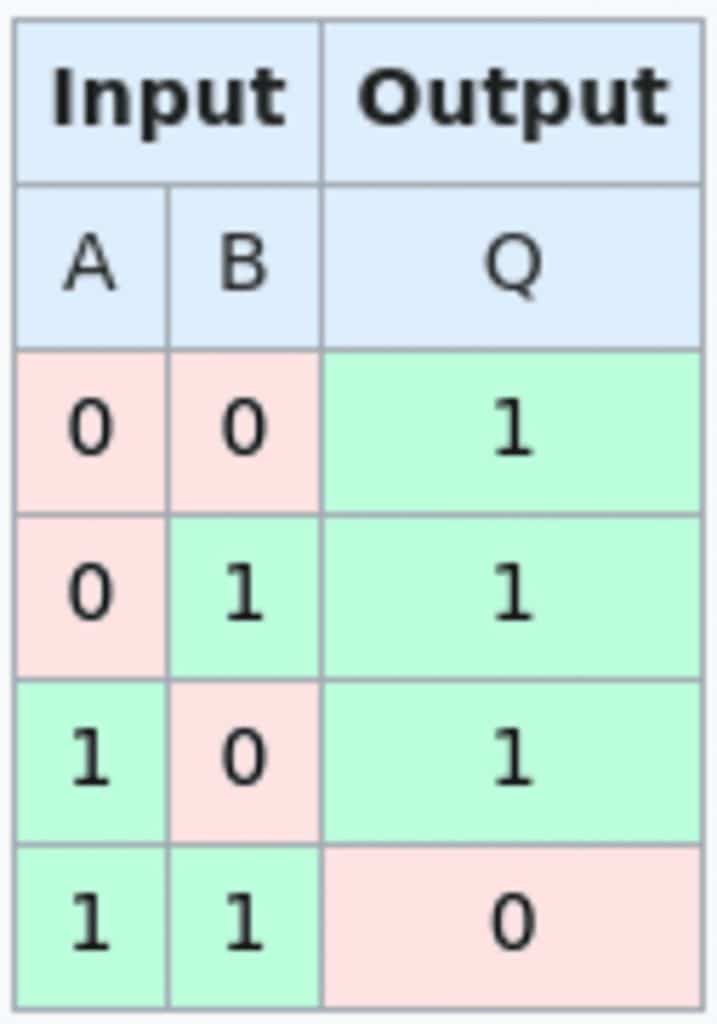
Figure 17. Schematic representation of NAND.
Source: “The Big Deal with BitVM: Arbitrary Computation now possible on Bitcoin without a fork” by Bitcoin Magazine
Building NAND Using Taproot and Merkle Tree
Detailed information about how BitVM facilitates building NAND using Taproot and Merkle trees, as well as its impact on computations, can be found in the technical documentation.
This approach allows for a precise, step-by-step verification of smart contract computations, aligning with the principles of blockchain integrity and security.
Challenges with Smart Contract Bilateralism
A significant issue persists in BitVM due to the bilateral structure of smart contracts, facilitating direct data exchange solely between the verifier and prover, excluding third-party involvement. This constraint impedes dApp development and mandates supplementary solutions for multi-party contract constructions.
Furthermore, the intricate and low-level characteristics of BitVM imply that the construction of functional products leveraging this foundation may extend over several years. Substantial development and innovation are imperative to translate this foundational technology into practical applications.
For a detailed deep dive don’t hesitate to read a BitVM Whitepaper – https://bitvm.org/bitvm.pdf
Conclusion
The RGB protocol is a technical development in the Bitcoin ecosystem, introducing functionalities for smart contract implementation and token issuance directly tied to the Bitcoin network. This is achieved through a combination of client-side validation and utilization of single-use seals, which link tokens to Bitcoin’s UTXOs while maintaining transaction privacy.
One of the primary technical advantages of RGB is its approach to scalability and privacy. By shifting the bulk of validation work off the Bitcoin blockchain and employing cryptographic methods for transaction verification, RGB effectively reduces the data burden on the blockchain. This approach is conducive to maintaining the efficiency of the network, especially as transaction volumes increase.
RGB’s compatibility with the Lightning Network is another significant aspect, allowing for more scalable and efficient transaction processing. This feature is particularly relevant given the growing demand for faster and more cost-effective transaction methods in the cryptocurrency space.
However, the complex nature of RGB’s technology presents challenges in terms of user accessibility and comprehension. The protocol’s architecture and the advanced cryptographic methods employed can be difficult to understand and implement, particularly for those new to blockchain technology. This complexity could hinder broader adoption and user engagement.
Additionally, while RGB enhances privacy by keeping contract data off the blockchain, this aspect also raises questions about data verifiability and the ability to audit transactions, which are crucial for certain applications and regulatory compliance.
RGB’s latest update, version 0.10, positions it as a notable contender in the evolving landscape of blockchain technologies, particularly against emerging protocols like Taproot Assets and BitVM. Unlike Taproot Assets, which focuses on leveraging the UTXO model of Taproot for token issuance on the Bitcoin network, RGB distinguishes itself with its advanced privacy features and off-chain data handling, offering a distinct approach to smart contract functionality and token management.
Likewise, while BitVM introduces a novel concept for decentralized computing on Bitcoin, RGB’s version 0.10 advancements in client-side validation, contract interfaces and a strict type system showcase its unique approach towards enhancing scalability and user interaction within the Bitcoin ecosystem. These improvements highlight RGB’s prowess at addressing scalability and efficiency challenges, areas where traditional and emerging protocols often face limitations.
The simplification of dependencies and integration processes in RGB’s latest version further indicates a focus on user experience and system stability, setting it apart from competitors. This positions RGB not only as a robust platform for privacy-focused and scalable smart contracts and token issuance but also as a forward-thinking solution in the broader blockchain space.
In conclusion, the RGB protocol is a significant technological development within the Bitcoin network, offering advanced capabilities for smart contracts and token issuance. It addresses key issues of scalability and privacy but faces challenges in terms of complexity and potential auditability. The ongoing development and future iterations of the protocol will likely focus on balancing these advanced capabilities with user accessibility and regulatory considerations.
Term References:
- Turing Complete: In practical terms, the system can execute any computational problem with sufficient time and memory. Most modern programming languages are Turing-complete, signifying their theoretical capacity to address any computational problem.
- Schema: A contract schema serves as the actual code for a smart contract, which can be used as a “contract template” by the issuers without the necessity of coding or auditing custom code provided by external sources. RGB schema is not a script but is a data structure.
- Discrete Log Contracts (DLCs) in the context of state channels are specialized smart contracts used primarily in the Bitcoin network. They enable private and efficient execution of complex financial agreements based on external events, like asset prices. DLCs operate off-chain, maintaining confidentiality of contract details and participant identities. They utilize external data sources, or oracles, for contract resolution. When integrated with state channels, DLCs enhance scalability by allowing multiple transaction settlements without congesting the blockchain, making them ideal for private, efficient financial transactions that depend on real-world outcomes.
- Storm – escrow-based trustless storage using zk-proofs. Storm combines escrow-based trustless storage with zero-knowledge proofs to facilitate secure and private transactions. In this system, data or assets are held in escrow and only released when specific conditions are met, ensuring a trustless environment where no central authority is needed. The integration of zk-proofs allows for the verification of these transactions while maintaining the utmost confidentiality, as they enable the validation of data without revealing any underlying details.
- Prometheus – arbitration-based trustless distributed computing. Prometheus represents an approach to decentralized computing, combining arbitration mechanisms for dispute resolution, trustless interactions for secure and decentralized operations, and the efficiency of state channels for off-chain computation management.
- A Reduced Instruction Set Computer is a type of microprocessor architecture that utilizes a small, highly-optimized set of instructions rather than the highly-specialized set of instructions typically found in other architectures.
Disclaimer
In line with the Trust Project guidelines, please note that the information provided on this page is not intended to be and should not be interpreted as legal, tax, investment, financial, or any other form of advice. It is important to only invest what you can afford to lose and to seek independent financial advice if you have any doubts. For further information, we suggest referring to the terms and conditions as well as the help and support pages provided by the issuer or advertiser. MetaversePost is committed to accurate, unbiased reporting, but market conditions are subject to change without notice.
About The Author
Cryptomeria Capital is a crypto fund backed by blockchain industry experts. The firm believes decentralized projects, cryptocurrencies, and Web 3.0 will dramatically reshape economic relations and focuses on ventures, tokens, and projects related to blockchain technology and crypto assets. Cryptomeria Capital supports transformation by providing early-stage financing for ambitious projects in a rapidly developing industry.
More articles

Cryptomeria Capital is a crypto fund backed by blockchain industry experts. The firm believes decentralized projects, cryptocurrencies, and Web 3.0 will dramatically reshape economic relations and focuses on ventures, tokens, and projects related to blockchain technology and crypto assets. Cryptomeria Capital supports transformation by providing early-stage financing for ambitious projects in a rapidly developing industry.

















































